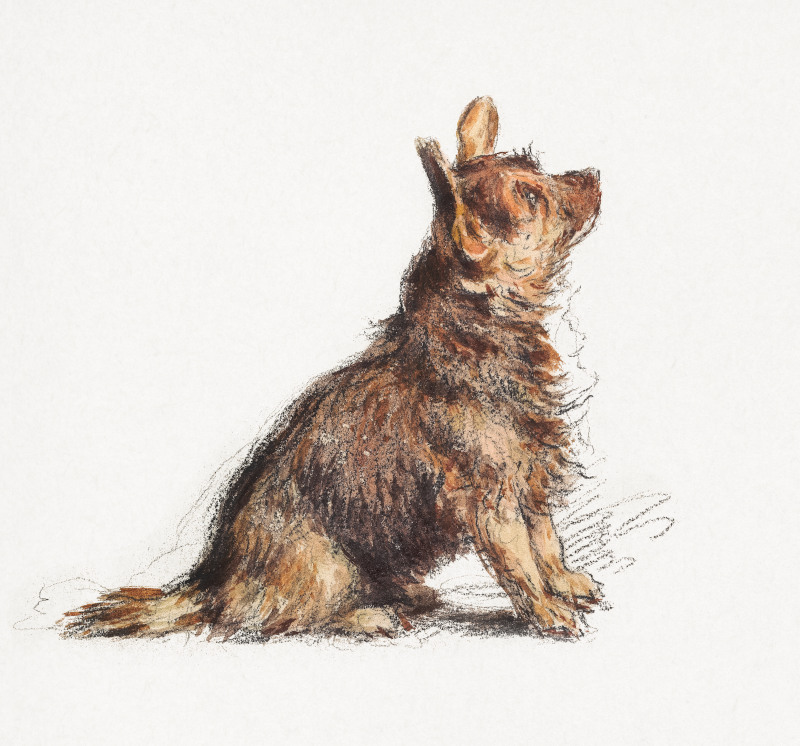Discover the beauty of dog art within this article which highlights famous dog drawings and paintings from art history and also gives advice on quick, easy drawings for budding artists.
Introduction to Dog Drawings
Dogs hold a special place in many of our hearts, and for that reason are popular choices within art. Their role as domesticated animals ensures a strong bond, in a similar manner to how many view cats as well. Both have been featured for centuries, and as such can be found in all manner of different styles, matching the methods of the time. Within this article we provide some inspiration for those looking to make some quick dog sketches, relatively easily, as well as giving more complex options for those at a more advanced stage.
Dogs are particularly common within amateur art, where people might want to celebrate their own pets. Within professional art, this topic is commercially viable, and requests can regularly be made for personal portraits. There was a rise in accuracy over the 18th and 19th century, but in more recent times the majority of dog drawings have been in more expressive, emotional styles that suit the transition into 20th and 21st century art.
List of Dog Drawings and Paintings
Find below a fine selection of dog artworks, covering all manner of different art movements and mediums in order to display the full range of methods used over the centuries to capture the beauty of this animal. Whilst the main focus is on drawings, paintings are also included to show the more complex options available, and hopefully some of those items listed below will provide you with the inspiration for work of your own. There remains a strong demand for this artistic genre, and it continues to be accessible to all audiences, regardless of their knowledge about art history.
Beneath the artworks are summarises about the artists who created each of them, and further below is discussion on a number of isses related to dog art, including the history behind it, and the best techniques that amateur artists can use for their work. Hopefully this article is as exhaustive on this topic as possible, and in the future we aim to include drawings of our own.
Dog Drawing (Terrier) by William Henry Hunt
This delightful drawing was completed by William Henry Hunt and features the use of pencil, along with a variety of color. One can see the outlines in place, from tones of dark grey, and we can imagine his working processes in completing this charming drawing. The dog looks up playfully, with an expression that we are all familiar with other dogs that we have come across at different points in our life. This was not just a quick sketch, but is well formed, with color, and could therefore have been presented as a gift to a friend by the artist himself.
 by William Henry Hunt.jpg) Dog Drawing (Terrier) by William Henry Hunt (courtesy of rawpixel)
Dog Drawing (Terrier) by William Henry Hunt (courtesy of rawpixel)
Basset Hound Dog, Vintage Illustration
This charming illustration features a Bassett Hound in side profile, and is considered a vintage drawing. The dog is perched with his front legs lifted up higher, which enables his back to remain straight on the horizontal. The dog looks calm and his tail lifts positively. The lines are intensely drawn, closely together to help simulate the direction and texture of dog hair. The artist loosely adds some touches across the ground in order to give some perspective to the piece.
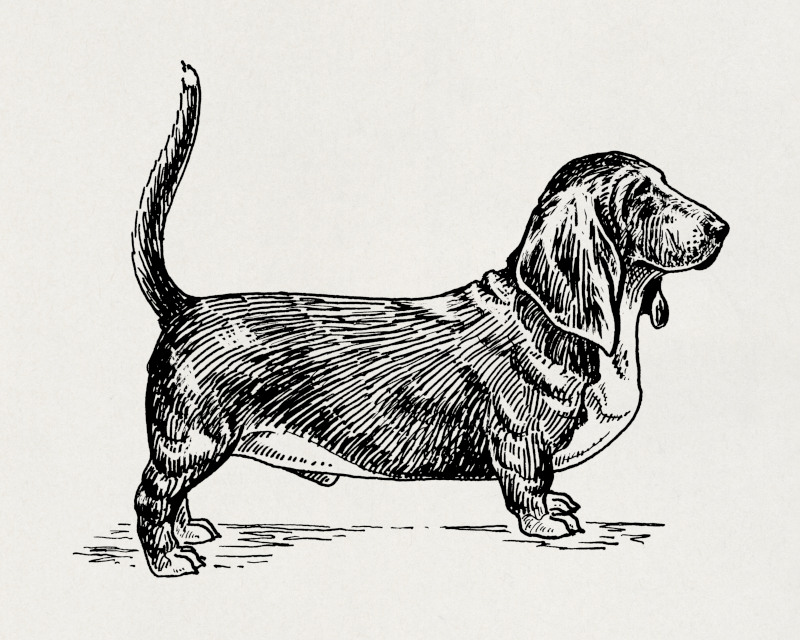 Basset Hound Dog, Vintage Illustration (courtesy of rawpixel)
Basset Hound Dog, Vintage Illustration (courtesy of rawpixel)
A King Charles Spaniel by Edouard Manet
This famous painting was completed by Edouard Manet and features a King Charles Spaniel in a remarkably detailed and lifelike portrait. How the artist was able to work with this subject is unclear, as the dog is unlikely to have stayed still for long. In the present day, photographs could have helped the process, but in the mid to late 19th century, photography was still very much an evolving technology and artists would tend instead just to make a number of sketches in a scenario such as this.
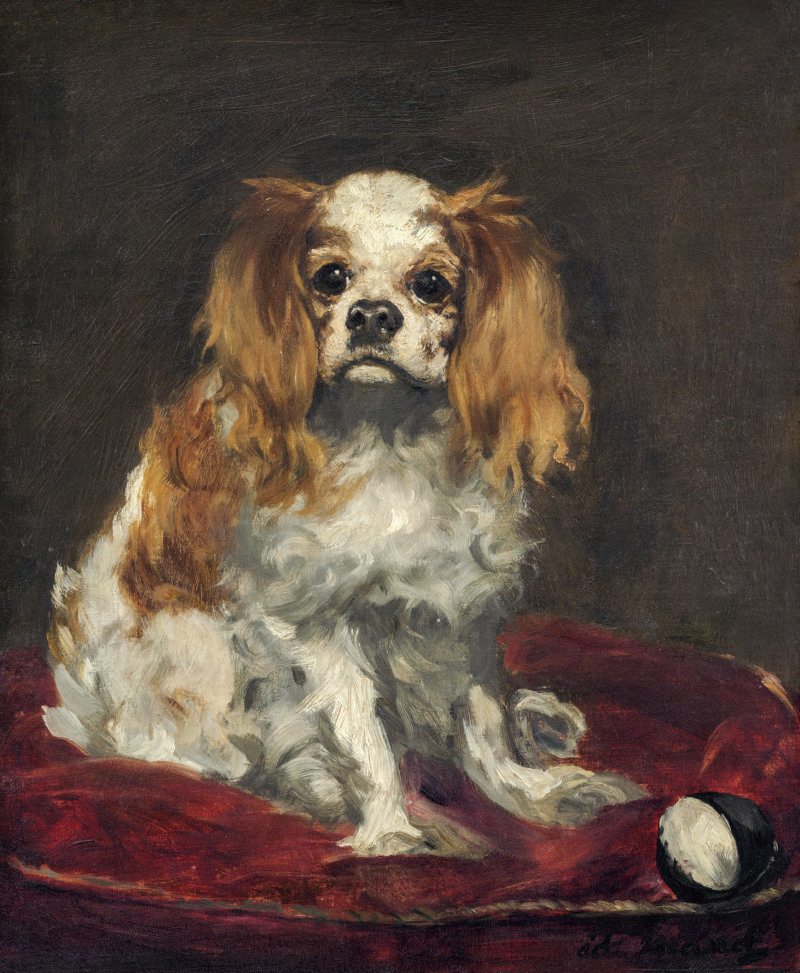 A King Charles Spaniel by Edouard Manet (courtesy of rawpixel)
A King Charles Spaniel by Edouard Manet (courtesy of rawpixel)
Brown and White Norfolk or Water Spaniel by George Stubbs
Here we can appreciate the stunning technical work of George Stubbs, one of Britain's finest animal artists. Here he captures a dog and places it in front of an imaginary landscape. Stubbs loved to study animal anatomy in detail, both through respected publications but also by slicing up corpses in his spare time. He left no stone unturned in the pursuit of accuracy, and this helped him to achieve the artistic success that he did. The most memorable element of this piece is the way in which the dog hair fluffs up and appears remarkably lifelike.
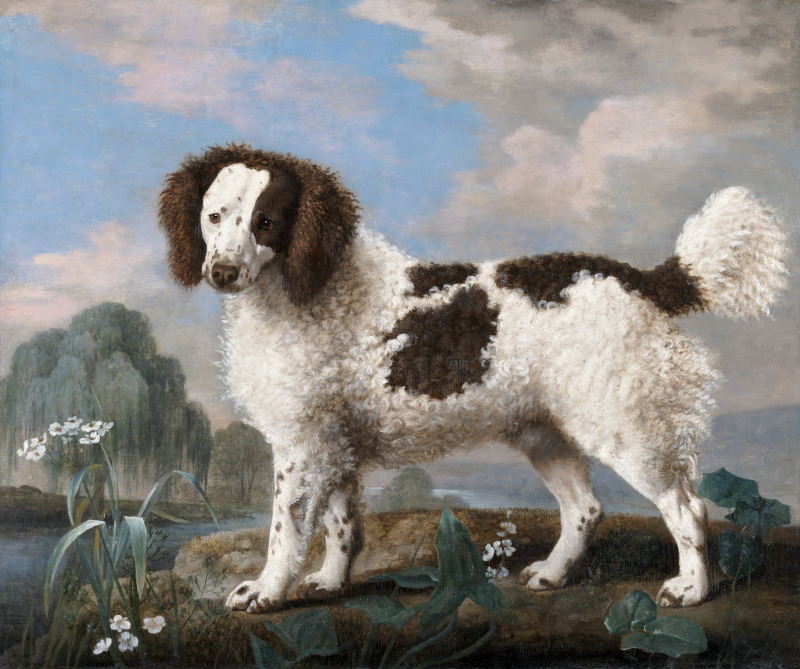 Brown and White Norfolk or Water Spaniel by George Stubbs
Brown and White Norfolk or Water Spaniel by George Stubbs
Nine Greyhounds in a Landscape by Jacques-Laurent Agasse
This delightful artwork by Jacques-Laurent Agasse features a whole plethora of greyhounds, placed within a stunning landscape setting. In the distance we can see a small building, along with some green fields. Blue sky cuts across the top, with tall trees framing the left hand side. The main focal point is clearly the dogs, who play together and form different poses as the artist illustrates his wide ranging technical skills as well as his specific knowledge about the anatomy and behavior of this particular breed of dog.
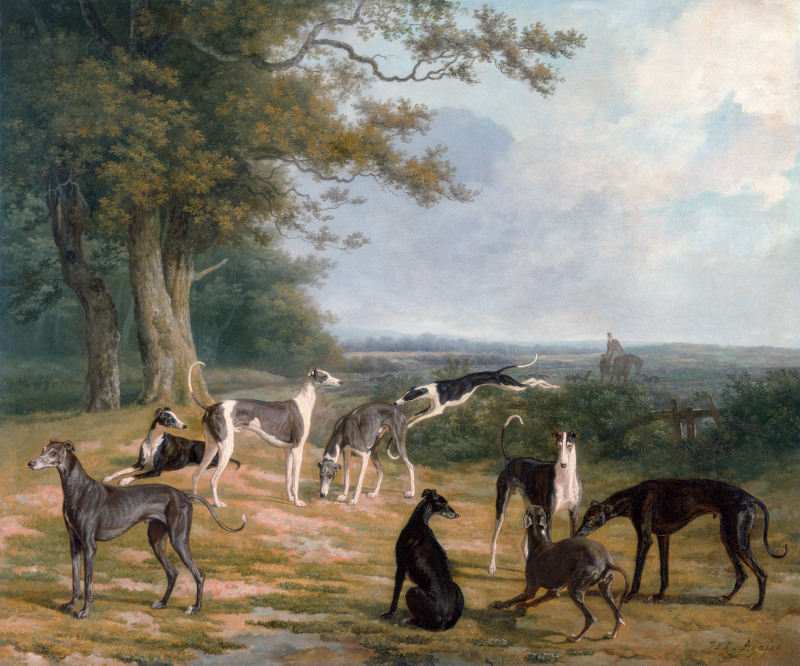 Nine Greyhounds in a Landscape by Jacques-Laurent Agasse
Nine Greyhounds in a Landscape by Jacques-Laurent Agasse
Two dogs by a kennel by Conradijn Cunaeus
Some artists would capture the relationship between man and dog, but others prefer to focus on the relationships between different dogs. This particular piece is truly charming as the smaller dog leans on his friend, with their eyes focused on each other. The 18th and 19th century were full of animal art, and perhaps that era marked the pinnacle within this genre, both in terms of the amount of work being produced on this theme, but also its technical prowess.
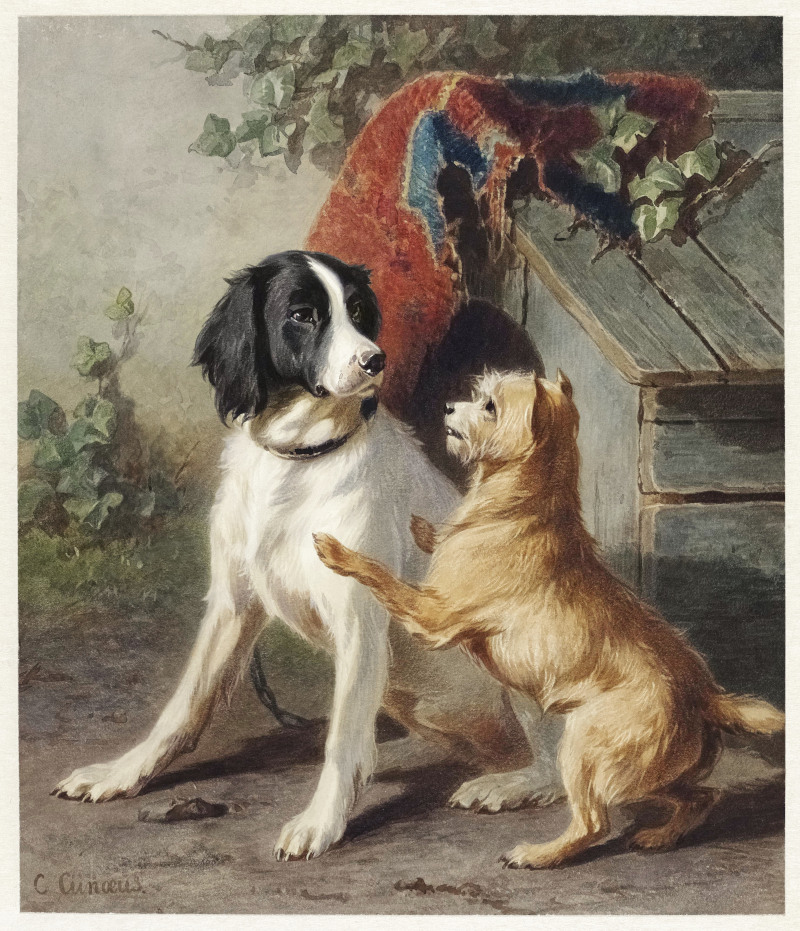 Two dogs by a kennel by Conradijn Cunaeus
Two dogs by a kennel by Conradijn Cunaeus
Vintage spaniel dog, animal illustration
This delightful spaniel looks off to our left in a detailed illustration which captures the balance of this animal, and displays knowledge of this specific breed of dog. The Spaniel is a particularly popular breed, due to its character and charming look, and perhaps that influenced the artist's decision to cover it here. A small part of the ground is added between the dog's legs, which helps to balance the composition and provide an element of perspective.
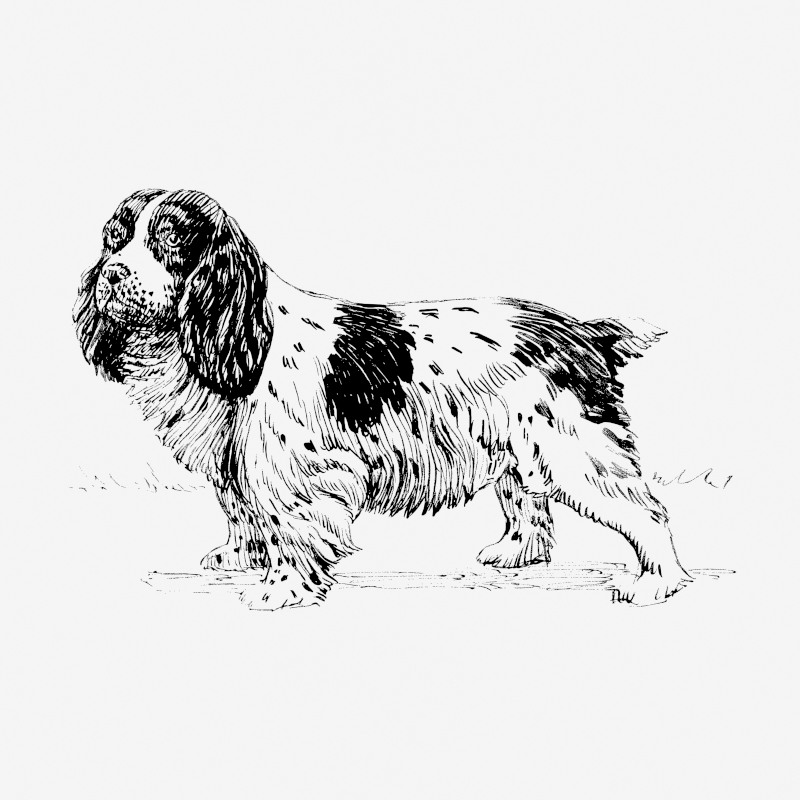 Vintage spaniel dog, animal illustration (courtesy of rawpixel)
Vintage spaniel dog, animal illustration (courtesy of rawpixel)
Dog head with a collar by Jean Bernard
This highly polished drawing was produced by a respected animal artist known as Jean Barnard. He would have spent a relatively long time on this drawing, in order to achieve such precision. Individual dog hair is considered in its direction, and particular care is taken around the dog's eyes and nose, which is where much of this breed's particular characteristics can be found. Its ears are folded back, and the dog boasts a fancy collar, suggesting that his owner is from a prestigious background.
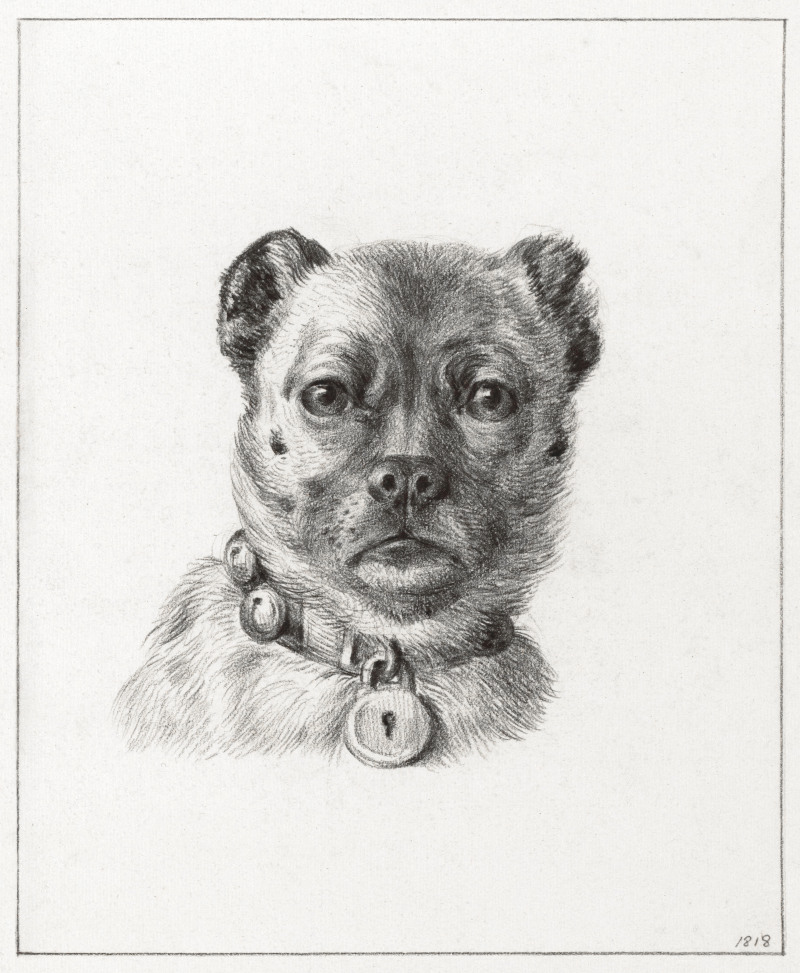 Dog head with a collar by Jean Bernard
Dog head with a collar by Jean Bernard
Setter dog line illustration
This vintage artwork captures a setter, with one leg lifted into the air in a playful manner. Colors are achieved by varying the intensity of the strokes of pen, and this also is used to create a touch of shadowing around the lower half of the dog's anatomy.
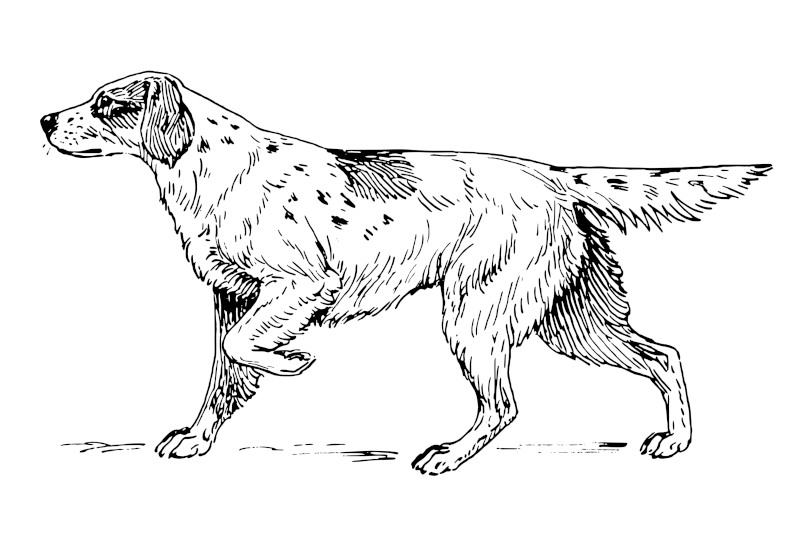 Setter dog line illustration (courtesy of rawpixel)
Setter dog line illustration (courtesy of rawpixel)
German shepherd dog drawing
The strength and confidence of the German shepherd breed is underlined in this excellent drawing. The dog stares off to the right hand side, with its tongue hanging down. Its ears stand equally proudly, and this dog looks a picture of health. In order to achieve a realistic look, the artist would have studied the various directions of the dogs hair across its body, as well as in how it varies over the various contours of the dogs muscle and bone structure. This breed remains amongst the most popular of all, ensuring this artwork would have been particularly well received.
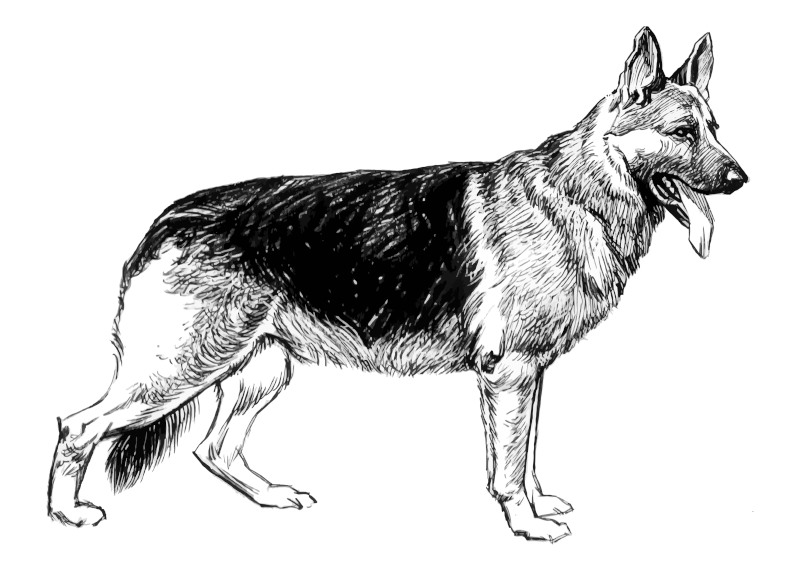 German shepherd dog drawing (courtesy of rawpixel)
German shepherd dog drawing (courtesy of rawpixel)
Schnauzer dog Standing Tall
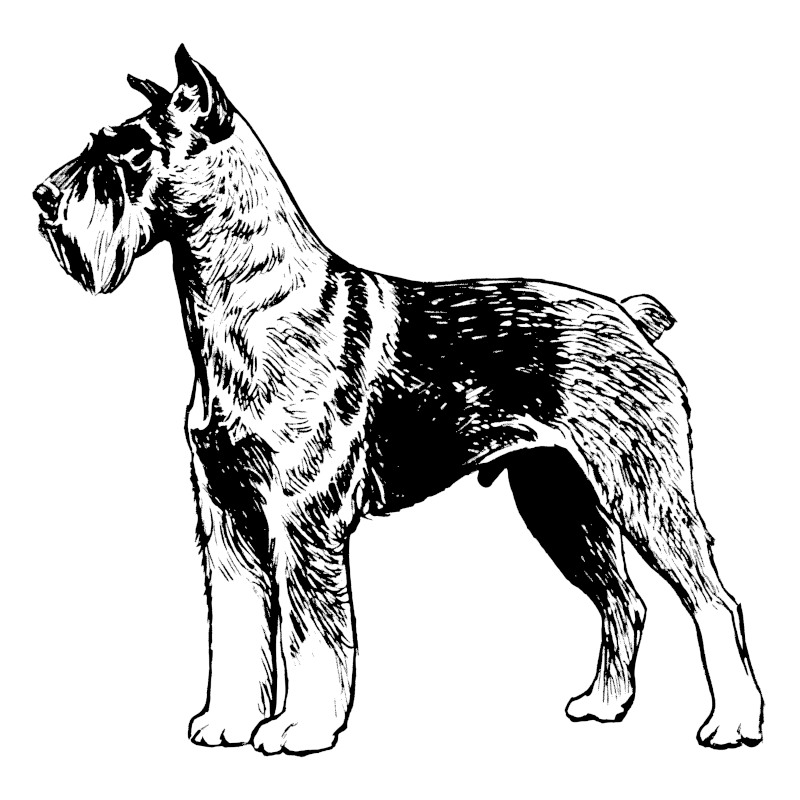 Schnauzer dog Standing Tall (courtesy of rawpixel)
Schnauzer dog Standing Tall (courtesy of rawpixel)
Sheepdog, Vintage animal Sketch
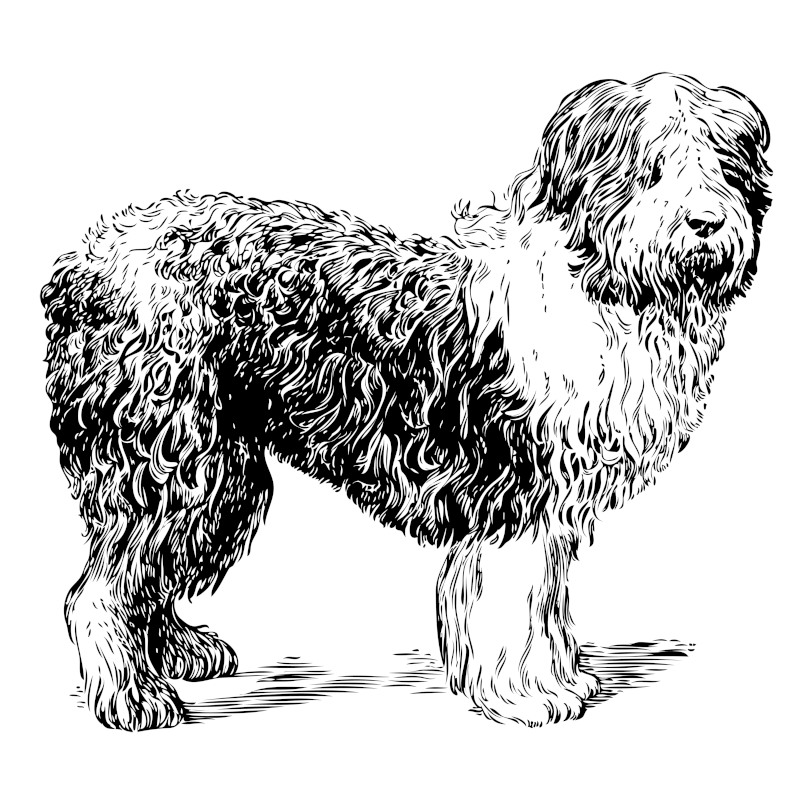 Sheepdog, Vintage animal Sketch (courtesy of rawpixel)
Sheepdog, Vintage animal Sketch (courtesy of rawpixel)
Introduction to Dog Drawings
Art is often about depicting relationships and emotions, and few connections can be as strong as that of a dog and its owner. Whilst many animal artists have focused on educating us about the anatomy of each animal, particularly when they are from exotic species, dogs in art have tended to be presented in a different manner, representing our closer relationships with domesticated animals. You will notice this by comparing the artworks in this article against our fish, butterfly and bird drawings.
The history of art can be said to illustrate how our relationship with dogs have evolved over time. For this creature was first seen in cave paintings, in ancient civilizations, and would not have been treated as pets at that time. Today, by contrast, many members of the public will request their own custom portraits, sat alongside their favorite pets as a memento to hang within their own homes and offices. Artistic techniques have also changed over time, with pencil and minimalist methods proving popular today.
History of Canine Art
Following their appearance in cave paintings, we would use start to see dogs in art during Ancient Egypt, Greece, and Rome, at which point that would adorn ceramics and paintings, as well as sculpture to a lesser degree. Their symbolic value differed from one culture to the next, with some using them for working purposes. By the time of the Renaissance, Europeans started to regard them as loyal creatures, and would use their presence in art as a symbol of that quality.
It was during the 18th and 19th century that dog art really took off, with accuracy improving considerably and the theme entering mainstream art circles for the first time. A number of artists made a name for themselves as specialists in animal art, and the accuracy of their work started to receive academic respect. By the 20th century, our relationship with dogs had evolved, and many artists would now start to concentrate on the emotional connection between ourselves and our pets.
Styles and Approaches
In order to reflect the styles of the day, dog art has appeared in many different movements over the years. Our focus is predominantly on the period of the 18th century up to the present day, and within that we have seen examples in an Impressionist manner, as well as Expressionism, Realism and more Abstract approaches. In more recent times that has been a strong use of dogs within cartoons, as well as book illustration. Often the more modern methods will be aimed at children, with animal characters proving popular with younger audiences.
Franz Marc is a popular choice for his depictions of animals, and covered dogs on several occasions. Many artworks today which gain support online are not actually from famous artists, but manage to gain interest through social media, which can sometimes allow their work to receive considerable exposure in a short space of time. A global audience can also appreciate art such as this, without needing any cultural understanding, and so the potential success for animal artists today is larger than it ever has been.
Famous Dog Artists
When considering famous dog artists, we tend to focus on artists who have covered a variety of animals within their careers. Few specialists in dogs alone have achieved worldwide fame, where as a number who have tackled the wider genre of animals have done so to great effect. The first ones that spring to mind are derived from European art of around the 18th and 19th century, which is precisely when the genre rose to prominence. The likesof Landseer and Stubbs remain household names within the realm of British art history and other names to be aware of includes Nicolas Toussaint Charlet, who specialised in lithographs and caricatures.
Whilst Stubbs is best known for Whistlejacket, featuring a horse, and Landseer for his Monarch of the Glen, some of their better known depictions of dogs included Eos, the Greyhound, Viscount Gormanston's White Dog and A Foxhound Called Ringwood. They worked with and studied many animals across their careers, sometimes analysing corpses in order to better understand anatomy and the structure of bone and muscle, all of which improved the accuracy of their work.
Inspiration from Real Dogs
Dogs are around us, more than almost any other animal. This makes them accessible for artistic purposes, but also helps us to naturally be very familiar with these particular animals. In order to raise our understanding even further, artists will spend extra time observing specific dogs in order to depict them as accurately as possible and in some cases might use their own pets in order to capture their particular personality. As artists look for variety, they will try out different breeds, each of which have their own unique characteristics, both in terms of personality, but also their aesthetic qualities.
Certain breeds will be more common in some cultures than others, and consequently will appear more often in art of those regions. Those unable to access particular dogs locally can now take advantage of high quality photography, which enables artists to focus on exotic breeds without seeing them in person. Many will sketch dogs quickly and loosely, before developing ideas at a later date from the comfort of their own home or studio.
The Role of Dog Drawings in Popular Culture
Dogs appear today in all manner of different sections of the media, including advertising, literature and internet content. Many dogs are filmed by their owners doing comedic things, whilst many children's books will be illustrated by characters based on dogs, cats and other animals. Advertisers find that dogs give many positive benefits to their brands and products, and can be used for many non-dog related items. Dog art can then be used to promote products with posters appearing in newspapers and magazines.
Cartoons are particularly common today, replacing many more traditional children's television formats, and dogs regularly appear within these animated stories. Asian cultures also make use of dogs, as well as cats, within modern society and have generated whole brands based on their favorite pets. Many modern cartoons will also be translated into multiple languages and sold globally, helping these ideas to spread.
Dog Art as a Therapeutic Outlet
Art can be a truly therapeutic activity, and the impact can be even greater when focusing on animals or nature. Sitting outdoors, perhaps alongside your pets, and occupying your mind with thoughts about a quick sketch can quickly remove other concerns from your mind. In today's world it can be impossible for some to block out anxieties without taking action proactively, and art remains one of the best options available. Additionally, for children, this can work particularly well, and avoids them becoming distracted by the digital world that continues to bring some negative effects on all of our lives.
The physical action of sketching, alongside the mental occupation on something as simple as drawing a dog, work together to relax the mind and body. When combined with other techniques, such as deep breathing exercises, considerable improvements have been made by some in terms of their mental health, and often these benefits will improve physical health alongside that. Many famous artists have turned to art as a form of therapy, and whilst we may not have quite their problems within our own minds, we can still look to take some of the same benefits into our own lives.
Exploring Canine Anatomy
There are a number of topics to consider when aiming for an accurate anatomy within your work. These include studying proportions across different dog breeds, as well as the variety in fur, including its thickness, direction and structure. Additionally, muscle and bone structure lay below the surface and need to be understood for those seeking the highest quality of work. Joints and limbs also can have their own intricacies to observe. The best methods for developing your understanding of these topics is to start simple, and then evolve through repetition and observation, remaining patient and humble. The best animal artists would tend to be those who went to the greatest efforts, both in terms of study time spent, and also technical practice.
Future Trends in Dog Art
Incredible detail can be added to dog portraits when using digital technology, to the point where viewers can zoom in to almost see individual hairs. This is because digital strokes can be expanded with ease, rather than when using photographs of existing artworks. This is using svg and other modern image technology, which is possible when the artwork was constructed originally within digital art software. You might also trace external works using the same software to achieve similar results. By working on tablets and other devices, it is much easier to translate your designs into art prints, or add them to other merchandise such as mugs and t-shirts, making them more efficient for commercial purposes.
Typically, those wanting to enjoy dog art would have to choose between existing artworks, but today we can request our own ideas. Portraits of our own dogs can be produced, from photographs. You might even create your own designs based on these, such as through tracing the original images, or completing quick sketches yourself. The public will today often organise prints by themselves, and tailor their walls to suit their own tastes, helping us all to be more creative within our own homes.



